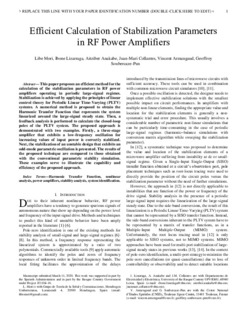Izenburua
Efficient Calculation of Stabilization Parameters in RF Power AmplifiersEgilea
Egilea (beste erakunde batekoa)
Argitalpen data
2020Beste erakundeak
Universidad del País Vasco/Euskal Herriko Unibertsitatea (UPV/EHU)Centre National d'Études Spatiales (CNES)
Bertsioa
PostprintaDokumentu-mota
ArtikuluaArtikuluaHizkuntza
IngelesaEskubideak
© 2020 IEEE. Personal use of this material is permitted. Permission from IEEE must be obtained for all other uses, in any current or future media, including reprinting/republishing this material for advertising or promotional purposes, creating new collective works, for resale or redistribution to servers or lists, or reuse of any copyrighted component of this work in other works.Sarbidea
Sarbide bahituaArgitaratzailearen bertsioa
https://doi.org/10.1109/TMTT.2020.3006185Non argitaratua
IEEE Transactions on Microwave Theory and Techniques Vol. 68. N. 9. Pp. 3686-3696, 2020Argitaratzailea
IEEEGako-hitzak
Harmonic Transfer Function
nonlinear analysis
power amplifiers
stability analysis ... [+]
nonlinear analysis
power amplifiers
stability analysis ... [+]
Harmonic Transfer Function
nonlinear analysis
power amplifiers
stability analysis
system identification [-]
nonlinear analysis
power amplifiers
stability analysis
system identification [-]
Laburpena
This paper proposes an efficient method for the calculation of the stabilization parameters in RF power amplifiers operating in periodic large-signal regimes. Stabilization is achieved by applying the ... [+]
This paper proposes an efficient method for the calculation of the stabilization parameters in RF power amplifiers operating in periodic large-signal regimes. Stabilization is achieved by applying the principles of linear control theory for Periodic Linear Time-Varying (PLTV) systems. A numerical method is proposed to obtain the Harmonic Transfer Function that represents the system linearized around the large-signal steady state. Then, a feedback analysis is performed to calculate the closed-loop poles of the PLTV system. The proposed approach is demonstrated with two examples. Firstly, a three-stage amplifier that exhibits a low-frequency oscillation for increasing values of input power is correctly stabilized. Next, the stabilization of an unstable design that exhibits an odd-mode parametric oscillation is presented. The results of the proposed technique are compared to those obtained with the conventional parametric stability simulation. These examples serve to illustrate the capability and efficiency of the proposed approach. [-]





















